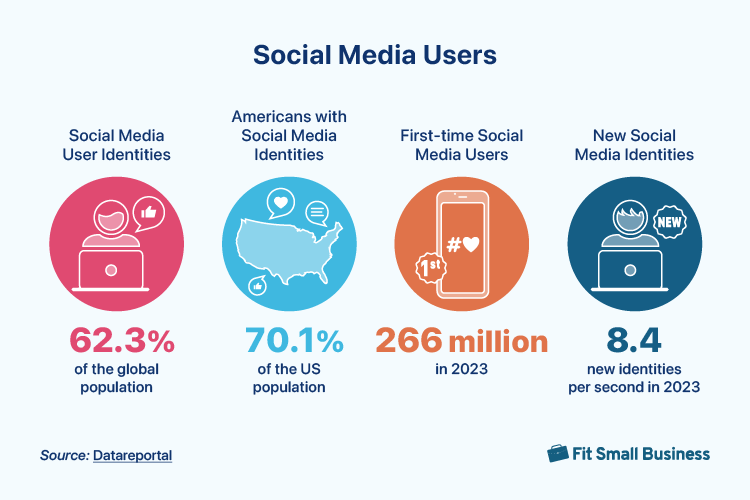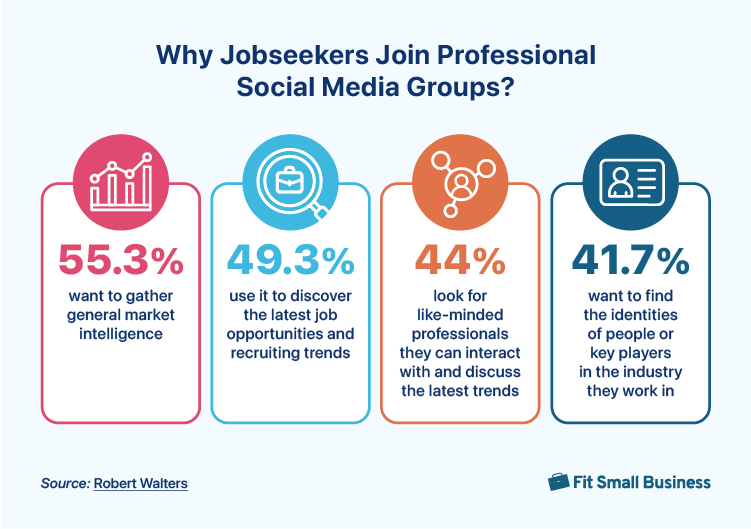With the popularity of TikTok, LinkedIn, and Facebook, many hiring managers and HR teams have turned to these social media platforms to post jobs and find qualified candidates. This social recruiting trend is expected to grow each year as it offers a strategic approach to attracting and hiring top talents. If you’re unsure whether to follow this trend or want data on how recruiters are using social media to support their hiring needs, we compiled 15 social media recruiting statistics for 2024.
Key Takeaways
- In the US, users spend an average of two hours and 18 minutes each day on social media.
- 79% of jobseekers are more likely to find potential work opportunities through social media platforms.
- LinkedIn is the platform of choice for employers to do social media recruiting, and for employees to job hunt and grow their professional network.
Social Media User Demographics
Before we dive into recruiting through social media statistics, let’s take a look at a few user demographics to see how many people utilize social media.
1. 62.3% of the world’s population are social media users
More than half of the world’s population (or around 5.04 billion people) have active social media user identities Note that user identities don’t refer to unique individuals because one person may have more than one social media account. However, the numbers of user identities and people using social media shouldn’t be too far off from each other, according to Datareportal’s Digital 2024 Global Overview Report. at the start of 2024. Compared to January 2023, the global total has increased by 5.6%. In the US, 70.1% of the total population have active social media user identities.
Further, 266 million people globally started using social media throughout 2023. On average, 8.4 new user identities per second were created last year. With that many social media user identities created every second, you can get a wider candidate reach to advertise job postings and boost hiring activities.
(Datareportal)

2. An average of two hours and 23 minutes are spent daily on social media
Globally, users aged 16 to 64 spent an average of two hours and 23 minutes on social media each day in 2023. In the US, the average time that users spent on social media was two hours and 18 minutes daily.
With social media users spending two hours daily online, active job seekers may likely see and apply to your listings if you post them on social media platforms like Facebook or LinkedIn. You might even attract passive candidates who may be open to exploring new career opportunities.
(Datareportal)
Recruitment through Social Media
3. Social media is among the top five recruiting channels
HR decision makers and recruiters use job boards as their top sourcing channel, but they also consider social media as a valuable resource (as well as internal hires, employee referrals, and applications via company career websites). Posting engaging content on TikTok, Instagram, or Facebook is one of the creative ways to attract and recruit employees.
(Jobvite)
4. 80% of employers use social media for employer brand promotions
One of the interesting social media and recruiting statistics we found is about employer branding promotions. While a company’s website is a popular option for promoting an organization’s employer brand, social media has also become an important marketing platform. You can use social media to showcase your company’s work culture and share employee engagement initiatives like leadership coaching sessions, company sports events, and employee-led committees (such as volunteer groups to help the community).
(Glassdoor)

A snapshot of TechnologyAdvice’s LinkedIn page showing information about its global workforce and company activities. (Source: Technology Advice LinkedIn)
5. 57% of recruiters plan to increase employer brand spending
With Generation Z (also known as Gen Z, iGen, Zoomers, or those born between 1997 and 2012) poised to take over a quarter of the global workforce by 2025, many recruiters predict an increase in their employer branding investments. Given that this generation grew up in a digital world surrounded by technology, promoting your employer brand on social media is one of the best ways to attract and retain Gen Z employees.
(LinkedIn)
6. 65% of in-house recruiters have dedicated social media accounts for employer branding and talent acquisition
Social media can help boost your hiring strategies given its wide reach. Having dedicated accounts just for recruiting and employer branding will help you stand out from competitors, especially in today’s competitive hiring market.
(Content Stadium)
7. Job vacancy-related posts received the most engagement in 2023
The social media content that received the most engagement in 2023 was job vacancy posts (43%), followed by “life at your company” topics (25%) and employee quotes or stories (16%). On the other hand, company news and event promotions are the least engaging topics—each scoring 8%.
For recruiters who are new to using social media for hiring, the above social media recruiting statistics can help you identify the topics to prioritize. Even if you don’t have open jobs, we recommend regularly posting workplace and employee-related content to raise the interest of potential candidates in exploring future work opportunities with your company.
(Content Stadium)
8. Organic social media recruiting is the second most used talent acquisition tactic among HR professionals—plus, it’s free!
While many HR professionals use hiring events to create awareness of their company’s open positions and directly connect with job seekers, organic social media recruiting allows them to attract potential candidates at no cost. Many platforms let you open social media accounts and create online posts to promote your company or open positions for free. You can even use it to message potential candidates and schedule online interviews.
(CareerArc)
9. 41% of recruiters use LinkedIn for social media sourcing
Social media recruiting statistics in 2023 show that LinkedIn was the primary social media sourcing platform for recruiters and talent acquisition professionals. Recruiters also plan to use it for future candidate research. Further, more than half (52%) of HR decision-makers rank LinkedIn as the top choice for finding quality candidates.
Other social media sourcing channels include Facebook (20%), Instagram (11%), and X (formerly Twitter) (10%). Recruiters also use YouTube (7%), TikTok (4%), and Snapchat (2%) to look for potential new employees.
(Jobvite)
10. 67% of employers use social media to research and screen candidates
Employers typically use top background check companies to verify candidate information, work experience, educational background, and basic personal details. However, you can also use social channels like Facebook, Instagram, and TikTok to research applicants, know about their professional or personal achievements, and check online activities for potential red flags, such as comments or posts that go against your company values.
(Zippia)
Jobseeker Experience With Social Media
11. 79% of jobseekers likely use social media to search for jobs
More than three-quarters of jobseekers (79%) are turning to social media platforms to find job opportunities. If you add that number to the 67% of job applications made via mobile devices, then incorporating a mobile recruiting strategy into your social media hiring efforts will help improve time-to-hire metrics.
(Glassdoor)
12. 58% of jobseekers research information about potential employers on social media
Jobseekers use social media to gain insight into a company’s general information and work environment. Apart from job opportunities and profiles of existing employees, they look for data that show an organization’s core values, vision statement, business philosophy, and mission statement.
(CareerArc/Harris Poll)
13. 55.3% of jobseekers sign up for professional groups on social media to gather market data and grow their network
Over two-thirds of jobseekers find social media sites, such as LinkedIn, as good platforms to grow their network and career. It has over 1 billion members in more than 200 countries and a wide range of professional expertise across industries. In addition to job hunting and getting general market intelligence, jobseekers join professional social media groups to find key players in the industry, connect with other professionals, and discuss new trends.
(Roberts Walters)

14. 48% of both Gen Z and millennials with work experience have applied to job posts they found on social media
Gen Z and millennials (those born between 1981 to 1996) with job experience are more likely to apply to job ads on social media than Gen X (those born between 1965 to 1980) and baby boomers (those born between 1946 to 1964). This is mainly because of the Gen Z and millennial workers’ exposure to the digital world during their growing years—they are more comfortable using technology than Gen X and baby boomers.
Other interesting recruiting through social media statistics about Gen Z and millennials who have work experience include their use of social media to connect with recruiters and employees of prospective employers to find career opportunities. They also are more likely to reach out to peers via social media for potential job leads.
(CareerArc/Harris Poll)
15. 85% of jobseekers have LinkedIn profiles
Of all the social media platforms available online, many jobseekers have profiles on LinkedIn. Apart from LinkedIn, other social media channels that are popular with jobseekers include Facebook (73.5%), X (formerly Twitter) (38.6%), Google+ (19.1%), and Instagram (15.6%).
As an employer, you can leverage LinkedIn’s wide global network to fuel your social recruiting activities and hire employees. For helpful recruiting tips, read our guide on how to find employees on LinkedIn.
(Roberts Walters)
Bottom Line
Knowing the latest social media recruiting statistics will help you to better plan talent acquisition strategies and find employees via social media platforms. While LinkedIn is the preferred sourcing channel and professional networking site for employers and employees, respectively, you may want to consider posting job ads and promoting your employer brand on other popular sites like Facebook, Instagram, and X (formerly Twitter). Not only will this widen your candidate reach, but it will also help you reach a diverse pool of potential employees.
References: Datareportal, Jobvite, Glassdoor, LinkedIn, Content Stadium, CareerArc, CareerArc/Harris Poll, Zippia, and Robert Walters
